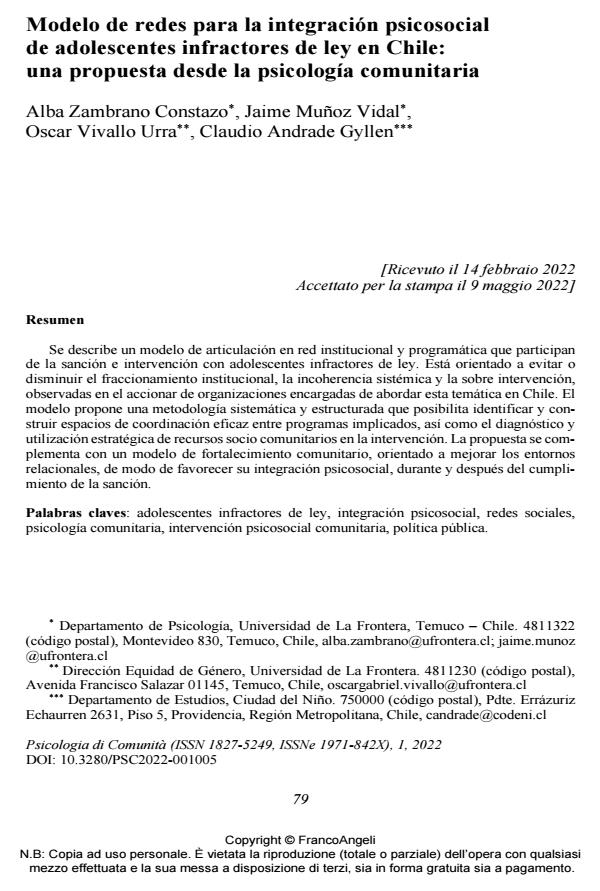Modelo de redes para la integración psicosocial de adolescentes infractores de ley en Chile: una propuesta desde la psicología comunitaria
Titolo Rivista PSICOLOGIA DI COMUNITA’
Autori/Curatori Alba Zambrano Constazo, Jaime Muñoz Vidal, Oscar Vivallo Urra, Claudio Andrade Gyllen
Anno di pubblicazione 2022 Fascicolo 2022/1
Lingua Spagnolo Numero pagine 23 P. 79-101 Dimensione file 1175 KB
DOI 10.3280/PSC2022-001005
Il DOI è il codice a barre della proprietà intellettuale: per saperne di più
clicca qui
Qui sotto puoi vedere in anteprima la prima pagina di questo articolo.
Se questo articolo ti interessa, lo puoi acquistare (e scaricare in formato pdf) seguendo le facili indicazioni per acquistare il download credit. Acquista Download Credits per scaricare questo Articolo in formato PDF

FrancoAngeli è membro della Publishers International Linking Association, Inc (PILA)associazione indipendente e non profit per facilitare (attraverso i servizi tecnologici implementati da CrossRef.org) l’accesso degli studiosi ai contenuti digitali nelle pubblicazioni professionali e scientifiche
Dating violence is alarmingly prevalent, highlighting the need to implement efficient pre-vention strategies. The objective of this pilot study was to evaluate the effects of the multi-component SPARX program. Results showed that school staff reported greater self-efficacy in answering questions regarding positive relationships and dating violence as well as know-ing how to react when a student confides a situation of dating violence. Parents and caregivers perceived a significant increase in their abilities to discuss positive romantic relationships with their teen, in recognizing the signs that their teen might be experiencing difficulties in their re-lationship and in guiding them towards help resources. Qualitative data revealed that youth appreciated the activities of the SPARX program.
La violenza nei rapporti di coppia tra i giovani (dating violence DV) è un fenomeno diffuso in maniera allarmante che evidenzia la necessità di attuare strategie di prevenzione efficaci. L’obiettivo di questo studio pilota era quello di valutare gli effetti del programma multicomponente SPARX. I risultati hanno mostrato che il personale scolastico ha riportato una maggiore auto-efficacia nel rispondere alle domande riguardanti le relazioni positive e il DV, e anche nel sapere come reagire nel momento in cui uno studente o una studentessa gli confidi una situazione di DV. I genitori e i caregiver hanno percepito un aumento significativo delle capacità di discutere di relazioni romantiche positive con i loro adolescenti, di riconoscere i segnali indicanti che i loro giovani potrebbero avere delle difficoltà nelle relazioni e di guidarli verso le risorse di aiuto. I dati qualitativi hanno rivelato che gli adolescenti hanno apprezzato le attività del programma SPARX.
Parole chiave:dating violence, prevenzione, programma multicomponente, approccio socio-ecologico, valutazione.
Alba Zambrano Constazo, Jaime Muñoz Vidal, Oscar Vivallo Urra, Claudio Andrade Gyllen, Modelo de redes para la integración psicosocial de adolescentes infractores de ley en Chile: una propuesta desde la psicología comunitaria in "PSICOLOGIA DI COMUNITA’" 1/2022, pp 79-101, DOI: 10.3280/PSC2022-001005